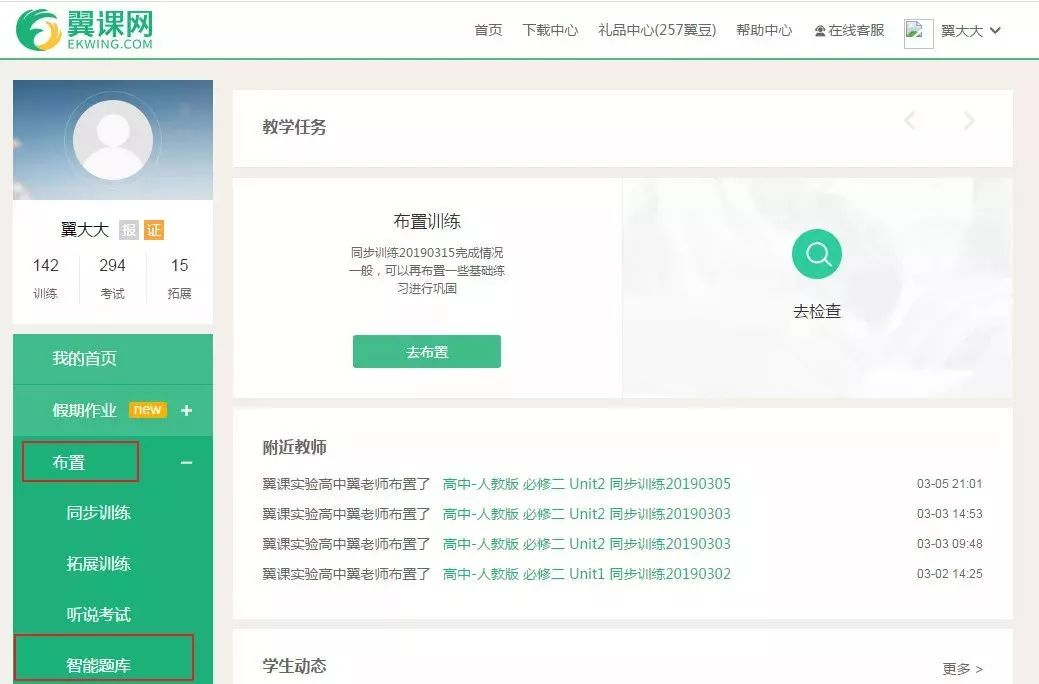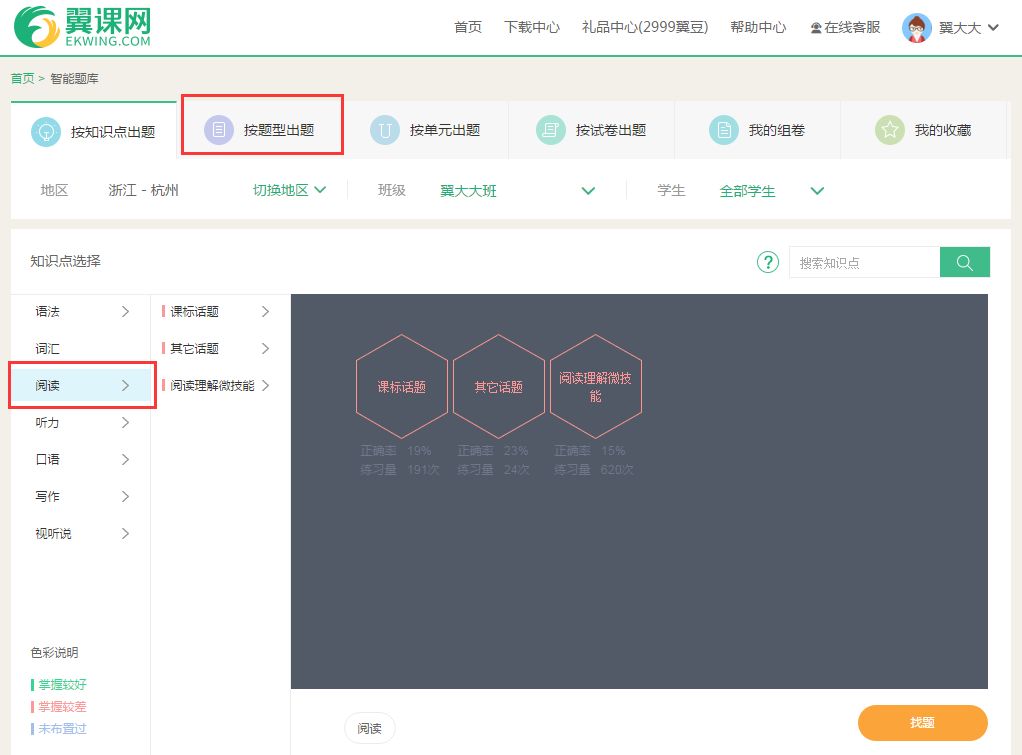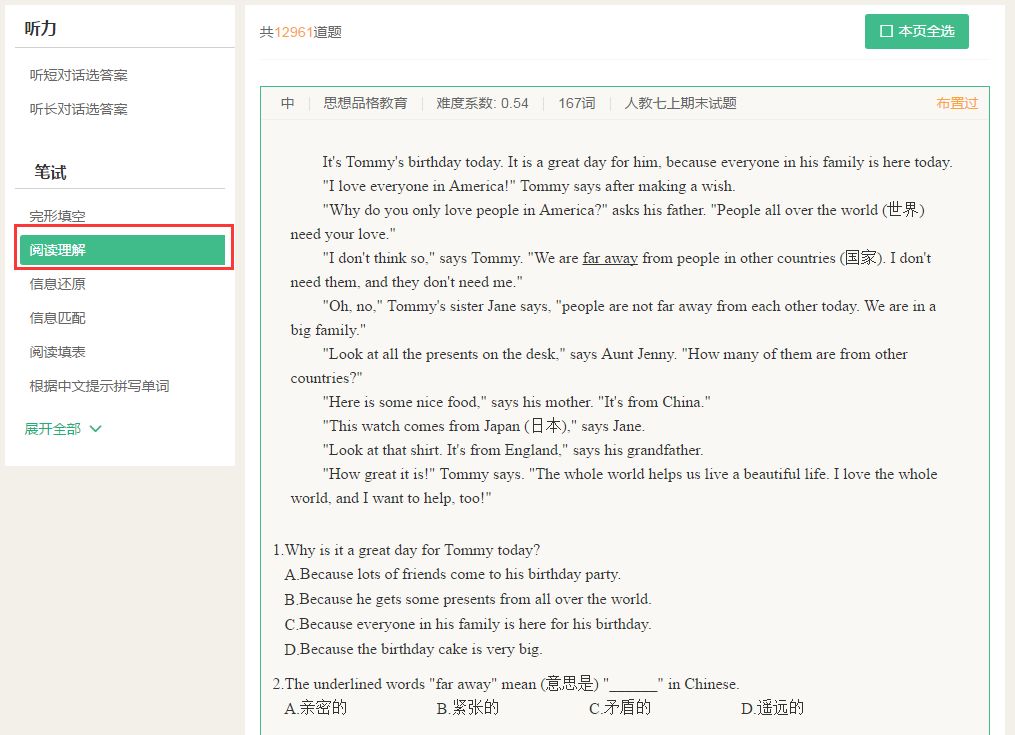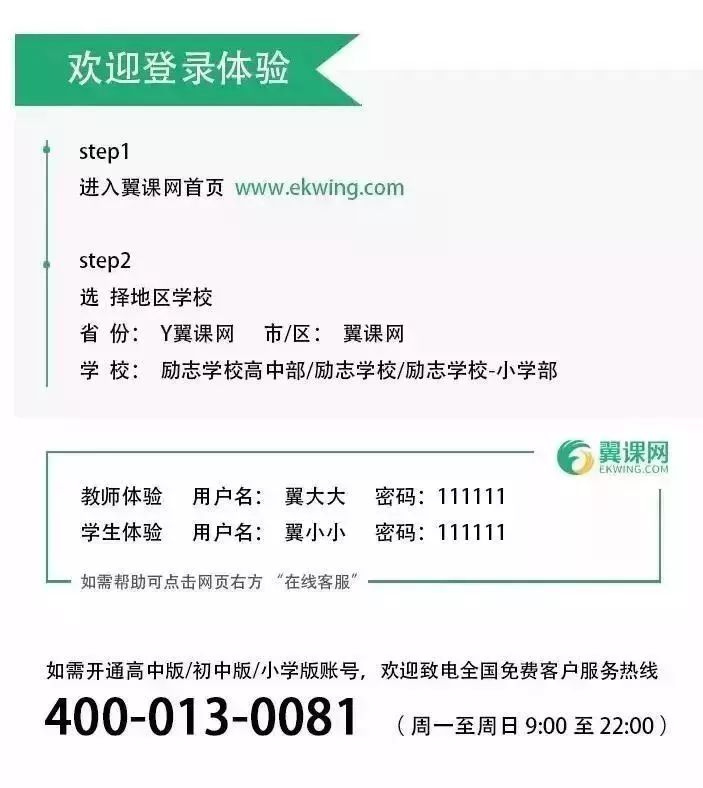一文讲全:高考英语“阅读理解题型”解读及备考策略 |
您所在的位置:网站首页 › celebrity英语阅读理解 › 一文讲全:高考英语“阅读理解题型”解读及备考策略 |
一文讲全:高考英语“阅读理解题型”解读及备考策略
|
引言: 阅读,是学生学习英语的重要途径之一。 在我国英语高考中,对学生阅读理解能力考查占比较大。从近两年英语高考命题可知,阅读篇章话题均在课标所要求的主题语境范畴之内,涵盖了人与自我、人与社会和人与自然;语篇类型包含应用文、记叙文、说明文、议论文等文体;该题型旨在考查考生根据具体主题语境,基于不同类型语篇,运用各种知识和策略,围绕所读材料建构意义的能力。 今天,翼课君就为大家整理了阅读理解题型解读及备考策略,助大家在高考中稳操胜券!
一、真题呈现 (选自 2018 年高考全国 I 卷) 阅读下列短文,从每题所给的 A、B、C 和 D 四个选项中, 选出最佳选项。 A Washington, D.C. Bicycle Tours Cherry Blossom Bike Tour in Washington, D.C. Duration: 3 hours This small group bike tour is a fantastic way to see the world-famous cherry trees with beautiful flowers of Washington, D.C. Your guide will provide a history lesson about the trees and the famous monuments where they blossom. Reserve your spot before availability — and the cherry blossoms — disappear! Washington Capital Monuments Bicycle Tour Duration: 3 hours (4 miles) Join a guided bike tour and view some of the most popular monuments in Washington, D.C. Explore the monuments and memorials on the National Mall as your guide shares unique facts and history at each stop. Guided tour includes bike, helmet, cookies and bottled water. Capital City Bike Tour in Washington, D.C. Duration: 3 hours Morning or Afternoon, this bike tour is the perfect tour for D.C. newcomers and locals looking to experience Washington, D.C. in a healthy way with minimum effort. Knowledgeable guides will entertain you with the most interesting stories about Presidents, Congress, memorials, and parks. Comfortable bikes and a smooth tour route (路线) make cycling between the sites fun and relaxing. Washington Capital Sites at Night Bicycle Tour Duration: 3 hours (7 miles) Join a small group bike tour for an evening of exploration in the heart of Washington, D.C. Get up close to the monuments and memorials as you bike the sites of Capitol Hill and the National Mall. Frequent stops are made for photo taking as your guide offers unique facts and history. Tour includes bike, helmet, and bottled water. All riders are equipped with reflective vests and safety lights. 21. Which tour do you need to book in advance? A. Cherry Blossom Bike Tour in Washington, D.C. B. Washington Capital Monuments Bicycle Tour. C. Capital City Bike Tour in Washington, D.C. D. Washington Capital Sites at Night Bicycle Tour. 22. What will you do on the Capital City Bike Tour? A. Meet famous people. B. Go to a national park. C. Visit well-known museums. D. Enjoy interesting stories. 23. Which of the following does the bicycle tour at night provide? A. City maps. B. Cameras. C. Meals. D. Safety lights. 展开全文A Washington, D.C. Bicycle Tours Cherry Blossom Bike Tour in Washington, D.C. Duration: 3 hours This small group bike tour is a fantastic way to see the world-famous cherry trees with beautiful flowers of Washington, D.C. Your guide will provide a history lesson about the trees and the famous monuments where they blossom. Reserve your spot before availability — and the cherry blossoms — disappear! Washington Capital Monuments Bicycle Tour Duration: 3 hours (4 miles) Join a guided bike tour and view some of the most popular monuments in Washington, D.C. Explore the monuments and memorials on the National Mall as your guide shares unique facts and history at each stop. Guided tour includes bike, helmet, cookies and bottled water. Capital City Bike Tour in Washington, D.C. Duration: 3 hours Morning or Afternoon, this bike tour is the perfect tour for D.C. newcomers and locals looking to experience Washington, D.C. in a healthy way with minimum effort. Knowledgeable guides will entertain you with the most interesting stories about Presidents, Congress, memorials, and parks. Comfortable bikes and a smooth tour route (路线) make cycling between the sites fun and relaxing. Washington Capital Sites at Night Bicycle Tour Duration: 3 hours (7 miles) Join a small group bike tour for an evening of exploration in the heart of Washington, D.C. Get up close to the monuments and memorials as you bike the sites of Capitol Hill and the National Mall. Frequent stops are made for photo taking as your guide offers unique facts and history. Tour includes bike, helmet, and bottled water. All riders are equipped with reflective vests and safety lights. 21. Which tour do you need to book in advance? A. Cherry Blossom Bike Tour in Washington, D.C. B. Washington Capital Monuments Bicycle Tour. C. Capital City Bike Tour in Washington, D.C. D. Washington Capital Sites at Night Bicycle Tour. 22. What will you do on the Capital City Bike Tour? A. Meet famous people. B. Go to a national park. C. Visit well-known museums. D. Enjoy interesting stories. 23. Which of the following does the bicycle tour at night provide? A. City maps. B. Cameras. C. Meals. D. Safety lights. B Good Morning Britain'sSusanna Reid is used to grilling guests on the sofa every morning, but she is cooking up a storm in her latest role — showing families how to prepare delicious and nutritious meals on a tight budget. In Save Money: Good Food, she visits a different home each week and with the help of chef Matt Tebbutt offers top tips on how to reduce food waste, while preparing recipes for under £5 per family a day. And the Good Morning Britain presenter says she's been able to put a lot of what she's learnt into practice in her own home, preparing meals for sons, Sam, 14, Finn, 13, and Jack, 11. “We love Mexican churros, so I buy them on my phone from my local Mexican takeaway restaurant,” she explains. “I pay £5 for a portion (一份), but Matt makes them for 26p a portion, because they are flour, water, sugar and oil. Everybody can buy takeaway food, but sometimes we're not aware how cheaply we can make this food ourselves.” The eight-part series (系列节目),Save Money: Good Food, follows in the footsteps of ITV's Save Money: Good Health, which gave viewers advice on how to get value from the vast range of health products on the market. With food our biggest weekly household expense, Susanna and Matt spend time with a different family each week. In tonight's Easter special they come to the aid of a family in need of some delicious inspiration on a budget. The team transforms the family's long weekend of celebration with less expensive but still tasty recipes. 24. What do we know about Susanna Reid? A. She enjoys embarrassing her guests. B. She has started a new programme. C. She dislikes working early in the morning. D. She has had a light budget for her family. 25. How does Matt Tebbutt help Susanna? A. He buys cooking materials for her. B. He prepares food for her kids. C. He assists her in cooking matters. D. He invites guest families for her. 26. What does the author intend to do in Paragraph 4? A. Summarize the previous paragraphs. B. Provide some advice for the readers. C. Add some background information. D. Introduce a new topic for discussion. 27. What can be a suitable title for the text? A. Keeping Fit by Eating Smart B. Balancing Our Daily Diet C. Making Yourself a Perfect Chef D. Cooking Well for Less B Good Morning Britain'sSusanna Reid is used to grilling guests on the sofa every morning, but she is cooking up a storm in her latest role — showing families how to prepare delicious and nutritious meals on a tight budget. In Save Money: Good Food, she visits a different home each week and with the help of chef Matt Tebbutt offers top tips on how to reduce food waste, while preparing recipes for under £5 per family a day. And the Good Morning Britain presenter says she's been able to put a lot of what she's learnt into practice in her own home, preparing meals for sons, Sam, 14, Finn, 13, and Jack, 11. “We love Mexican churros, so I buy them on my phone from my local Mexican takeaway restaurant,” she explains. “I pay £5 for a portion (一份), but Matt makes them for 26p a portion, because they are flour, water, sugar and oil. Everybody can buy takeaway food, but sometimes we're not aware how cheaply we can make this food ourselves.” The eight-part series (系列节目),Save Money: Good Food, follows in the footsteps of ITV's Save Money: Good Health, which gave viewers advice on how to get value from the vast range of health products on the market. With food our biggest weekly household expense, Susanna and Matt spend time with a different family each week. In tonight's Easter special they come to the aid of a family in need of some delicious inspiration on a budget. The team transforms the family's long weekend of celebration with less expensive but still tasty recipes. 24. What do we know about Susanna Reid? A. She enjoys embarrassing her guests. B. She has started a new programme. C. She dislikes working early in the morning. D. She has had a light budget for her family. 25. How does Matt Tebbutt help Susanna? A. He buys cooking materials for her. B. He prepares food for her kids. C. He assists her in cooking matters. D. He invites guest families for her. 26. What does the author intend to do in Paragraph 4? A. Summarize the previous paragraphs. B. Provide some advice for the readers. C. Add some background information. D. Introduce a new topic for discussion. 27. What can be a suitable title for the text? A. Keeping Fit by Eating Smart B. Balancing Our Daily Diet C. Making Yourself a Perfect Chef D. Cooking Well for Less C Languages have been coming and going for thousands of years, but in recent times there has been less coming and a lot more going. When the world was still populated by hunter-gatherers, small, tightly knit (联系)groups developed their own patterns of speech independent of each other. Some language experts believe that 10,000 years ago, when the world had just five to ten million people, they spoke perhaps 12,000 languages between them. Soon afterwards, many of those people started settling down to become farmers, and their languages too became more settled and fewer in number. In recent centuries, trade, industrialization, the development of the nation-state and the spread of universal compulsory education, especially globalisation and better communications in the past few decades, all have caused many languages to disappear, and dominantlanguages such as English, Spanish and Chinese are increasingly taking over. At present, the world has about 6,800 languages. The distribution of these languages is hugely uneven. The general rule is that mild zones have relatively few languages, often spoken by many people while hot, wet zones have lots, often spoken by small numbers. Europe has only around 200 Languages; the Americas about 1,000; Africa 2 400; and Asia and the Pacific perhaps 3,200, of which Papua New Guinea alone accounts for well over 800. The median number (中位数) of speakers is a mere 6,000, which means that half the world's languages are spoken by fewer people than that. Already well over 400 of the total of, 6,800 languages are close to extinction (消亡), with only a few elderly speakers left. Pick, at random, Busuu in Cameroon (eight remaining speakers), Chiapaneco in Mexico (150), Lipan Apache in the United States (two or three) or Wadjigu in Australia (one, with a question-mark): none of these seems to have much chance of survival. 28. What can we infer about languages in hunter-gatherer times? A. They developed very fast. B. They were large in number. C. They had similar patterns. D. They were closely connected. 29. Which of the following best explains “dominant” underlined in Paragraph 2? A. Complex. B. Advanced. C. Powerful. D. Modern. 30. How many languages are spoken by less than 6,000 people at present? A. About 6,800. B. About 3,400. C. About 2,400. D. About 1,200. 31. What is the main idea of the text? A. New languages will be created. B. People's lifestyles are reflected in languages. C. Human development results in fewer languages. D. Geography determines language evolution. C Languages have been coming and going for thousands of years, but in recent times there has been less coming and a lot more going. When the world was still populated by hunter-gatherers, small, tightly knit (联系)groups developed their own patterns of speech independent of each other. Some language experts believe that 10,000 years ago, when the world had just five to ten million people, they spoke perhaps 12,000 languages between them. Soon afterwards, many of those people started settling down to become farmers, and their languages too became more settled and fewer in number. In recent centuries, trade, industrialization, the development of the nation-state and the spread of universal compulsory education, especially globalisation and better communications in the past few decades, all have caused many languages to disappear, and dominantlanguages such as English, Spanish and Chinese are increasingly taking over. At present, the world has about 6,800 languages. The distribution of these languages is hugely uneven. The general rule is that mild zones have relatively few languages, often spoken by many people while hot, wet zones have lots, often spoken by small numbers. Europe has only around 200 Languages; the Americas about 1,000; Africa 2 400; and Asia and the Pacific perhaps 3,200, of which Papua New Guinea alone accounts for well over 800. The median number (中位数) of speakers is a mere 6,000, which means that half the world's languages are spoken by fewer people than that. Already well over 400 of the total of, 6,800 languages are close to extinction (消亡), with only a few elderly speakers left. Pick, at random, Busuu in Cameroon (eight remaining speakers), Chiapaneco in Mexico (150), Lipan Apache in the United States (two or three) or Wadjigu in Australia (one, with a question-mark): none of these seems to have much chance of survival. 28. What can we infer about languages in hunter-gatherer times? A. They developed very fast. B. They were large in number. C. They had similar patterns. D. They were closely connected. 29. Which of the following best explains “dominant” underlined in Paragraph 2? A. Complex. B. Advanced. C. Powerful. D. Modern. 30. How many languages are spoken by less than 6,000 people at present? A. About 6,800. B. About 3,400. C. About 2,400. D. About 1,200. 31. What is the main idea of the text? A. New languages will be created. B. People's lifestyles are reflected in languages. C. Human development results in fewer languages. D. Geography determines language evolution. D We may think we're a culture that gets rid of our worn technology at the first sight of something shiny and new, but a new study shows that we keep using our old devices (装置) well after they go out of style. That's bad news for the environment — and our wallets — as these outdated devices consume much more energy than the newer ones that do the same things. To figure out how much power these devices are using, Callie Babbitt and her colleagues at the Rochester Institute of Technology in New York tracked the environmental costs for each product throughout its life — from when its minerals are mined to when we stop using the device. This method provided a readout for how home energy use has evolved since the early 1990s. Devices were grouped by generation. Desktop computers, basic mobile phones, and box-set TVs defined 1992. Digital cameras arrived on the scene in 1997. And MP3 players, smart phones, and LCD TVs entered homes in 2002, before tablets and e-readers showed up in 2007. As we accumulated more devices, however, we didn't throw out our old ones. "The living-room television is replaced and gets planted in the kids'room, and suddenly one day, you have a TV in every room of the house,” said one researcher. The average number of electronic devices rose from four per household in 1992 to 13 in 2007. We're not just keeping these old devices — we continue to use them. According to the analysis of Babbitt's team, old desktop monitors and box TVs with cathode ray tubes are the worst devices with their energy consumption and contribution to greenhouse gas emissions (排放) more than doubling during the 1992 to 2007 window. So what's the solution (解决方案)? The team's data only went up to 2007, but the researchers also explored what would happen if consumers replaced old products with new electronics that serve more than one function, such as a tablet for word processing and TV viewing. They found that more on-demand entertainment viewing on tablets instead of TVs and desktop computers could cut energy consumption by 44%. 32. What does the author think of new devices? A. They are environment-friendly. B. They are no better than the old. C. They cost more to use at home. D. They go out of style quickly. 33. Why did Babbitt's team conduct the research? A. To reduce the cost of minerals. B. To test the life cycle of a product. C. To update consumers on new technology. D. To find out electricity consumption of the devices. 34. Which of the following uses the least energy? A. The box-set TV. B. The tablet. C. The LCD TV. D. The desktop computer. 35. What does the text suggest people do about old electronic devices? A. Stop using them. B. Take them apart. C. Upgrade them. D. Recycle them. D We may think we're a culture that gets rid of our worn technology at the first sight of something shiny and new, but a new study shows that we keep using our old devices (装置) well after they go out of style. That's bad news for the environment — and our wallets — as these outdated devices consume much more energy than the newer ones that do the same things. To figure out how much power these devices are using, Callie Babbitt and her colleagues at the Rochester Institute of Technology in New York tracked the environmental costs for each product throughout its life — from when its minerals are mined to when we stop using the device. This method provided a readout for how home energy use has evolved since the early 1990s. Devices were grouped by generation. Desktop computers, basic mobile phones, and box-set TVs defined 1992. Digital cameras arrived on the scene in 1997. And MP3 players, smart phones, and LCD TVs entered homes in 2002, before tablets and e-readers showed up in 2007. As we accumulated more devices, however, we didn't throw out our old ones. "The living-room television is replaced and gets planted in the kids'room, and suddenly one day, you have a TV in every room of the house,” said one researcher. The average number of electronic devices rose from four per household in 1992 to 13 in 2007. We're not just keeping these old devices — we continue to use them. According to the analysis of Babbitt's team, old desktop monitors and box TVs with cathode ray tubes are the worst devices with their energy consumption and contribution to greenhouse gas emissions (排放) more than doubling during the 1992 to 2007 window. So what's the solution (解决方案)? The team's data only went up to 2007, but the researchers also explored what would happen if consumers replaced old products with new electronics that serve more than one function, such as a tablet for word processing and TV viewing. They found that more on-demand entertainment viewing on tablets instead of TVs and desktop computers could cut energy consumption by 44%. 32. What does the author think of new devices? A. They are environment-friendly. B. They are no better than the old. C. They cost more to use at home. D. They go out of style quickly. 33. Why did Babbitt's team conduct the research? A. To reduce the cost of minerals. B. To test the life cycle of a product. C. To update consumers on new technology. D. To find out electricity consumption of the devices. 34. Which of the following uses the least energy? A. The box-set TV. B. The tablet. C. The LCD TV. D. The desktop computer. 35. What does the text suggest people do about old electronic devices? A. Stop using them. B. Take them apart. C. Upgrade them. D. Recycle them.
二、题型介绍 1.任务要求 要求考生根据所提供的四篇短文内容,从每题所给的A、B、C和D四个选项中,选出最佳答案。 2.考查要点 要求考生能读懂书、报、杂志中关于一般性话题的简短文段以及公告、说明、广告等,并能从中获取相关细信息。 考生应能: (1)理解主旨要义; (2)理解文中具体信息; (3)根据上下文推断单词和短语的含义; (4)做出判断和推理; (5)理解文章的基本结构; (6)理解作者的意图、观点和态度。 三、试题分析 1.考查目标 本题型主要考查考生阅读理解书面英语的能力。 2.考查方式和要求 阅读理解部分包含 A、B、C、D四篇短文(不少于 900 词),共 15 小题,每小题 2 分,采用“四选一”的命题形式,要求考生从每题所给的4个选项中选出最佳选项。 3.内容要求 主题语境不仅规约着语言知识和文化知识的学习范围,还为语言学习提供意义语境,并有机渗透情感、态度和价值观。学生对主题语境和语篇理解的深度,直接影响学生的思维发展水平和语言学习成效。本文第一部分真题中,A 篇主要介绍了在华盛顿特区骑自行车观光的路线、主要景点和从事的活动,属于“人与自我”的范畴; B 篇主要介绍了英国的一档电视节目,属于“人与社会”的范畴;C 篇主要介绍了全球语言多样性的发展变化以及现在面临的危机,属于“人与社会”的范畴;D 篇主要介绍了生活中常见的过时电子设备存在的问题,并提出了解决方案,属于“人与社会”的范畴。 4.语篇类型 不同的语篇类型为学生接触真实社会生活中丰富的语篇形式提供了机会。本文第一部分真题中,A 篇是应用文,B 篇是说明文,C 篇是说明文,D 篇是议论文。四种不同的语篇类型,使考生接触到真实、多样的语篇材料,体验不同的情感,使考生通过阅读来学习语言和人文、科学知识,通过阅读来拓展思维能力、提高评价能力。 四、备考策略 1.答题策略 阅读理解的题目中,既考查考生对文章中的关键词句、某些细节、某些段落是否理解,又考查考生对文章的主旨大意、作者意图、篇章结构是否掌握。它不仅能检测考生的理解、推断、概括等逻辑思维能力,而且对考生的心理素质也是一种考验。下面翼课君将从阅读理解考查要点方面逐一做试题分析,并提出相应的解题技巧。 (1)主旨大意题 主旨大意题一般是针对文章的主要内容、段落大意、文章标题等方面的提问,主要考查考生归纳总结以及概括能力。提问方式示例如下: What is the main idea of the text? What does the text mainly tell us? What would be the best title for the text? The main idea ofthe first/second/third paragraph is ___________. Paragraph 1/2/3 mainly deals with ___________. 本文第一部分真题中的 27、31 题为主旨大意题。举例如下: [真题再现] 27. What can be a suitable title for the text? A.Keeping Fit by Eating Smart B.Balancing Our Daily Diet C.Making Yourself a Perfect Chef D.Cooking Well for Less 答案:D。主旨大意题。 本文介绍了 Susanna Reid 主持的一个电视节目,介绍如何少花钱做出美味又有营养的饭菜,因此最佳标题是 Cooking Well for Less。 [解题技巧] 解答此类题时要抓住文章的主题句。有时从文章的第一个段落,甚至第一个句子即可得出文章的主旨要义;有时主题句在段落的末尾一句,是对文章的概括总结;有时文章无明显的主题句,而是把主题隐含在文章之中,需要考生从文章的字里行间进行归纳和概括。 (2)细节理解题 细节理解题是要求考生对文章中的某一事实细节进行理解,包含具体的事实和抽象的概念,可分为直接信息题和间接信息题。提问方式示例如下: What did they do in the park? Why did Tom refuse to accept help? How did they get in touch with each other? Who discovered the secret? 本文第一部分真题中的 21、22、23、25、30、33、34 题为细节理解题。举例如下: [真题再现] 21.Which tour do you need to book in advance? A.Cherry Blossom Bike Tour in Washington, D.C. B.Washington Capital Monuments Bicycle Tour. C.Capital City Bike Tour in Washington, D.C. D.Washington Capital Sites at Night Bicycle Tour. 答案:A。细节理解题。 根据第一段中“Reserveyour spot before availability — and the cherry blossoms — disappear!”可知,选择“Cherry Blossom Bike Tour in Washington, D.C.”这条线路时需提前预定。 [解题技巧] 解答此类问题时,首先要明确问题,从问题中寻找关键词,然后定位到文章中的某个地方,在理解文章的基础上,对比问题下面的选项,理清各选项的含义及其差别,去确定最佳答案。 (3)词义猜测题 词义猜测题主要是考查考生根据上下文去推测单词、短语或句子的意义的能力,重点是对语境的分析和处理能力。提问方式示例如下: What does the underlined word “...” in Paragraph 1/2/3 probably mean? The underlined word“...” in Paragraph 1/2/3 probably means___________. What do you think the phrase “...” stands for? What does the underlined sentence in Paragraph 1/2/3 mean? 本文第一部分真题中的29题为词义猜测题。举例如下: [真题再现] 29. Which of the following best explains“dominant” underlined in Paragraph 2? A.Complex. B.Advanced. C.Powerful. D.Modern. 答案:C。词义猜测题。 根据第二段中“all have caused many languages to disappear, and dominant languages such as English, Spanish and Chineseare increasingly taking over.”可知,很多种语言已经消失,英语、西班牙语、汉语逐渐占据主导地位。 [解题技巧] 词义猜测题可以根据上下文语境,利用同位语、定义、文章中的举例、对比或比较的词语、因果关系、转折关系、构词法等来对生词进行猜测。 (4)推理判断题 推理判断题是考查考生在理解文章字面意思的基础上,通过细节的暗示和逻辑关系的分析去推测文章隐含意思的能力,考生需领会作者的言外之意,并做出正确的判断。提问方式示例如下: It can be inferred from the text that ___________. The writer suggests that ___________. The story implies that ___________. What can we learn about...? 本文第一部分真题中的24、28、32、35题为推理判断题。举例如下: [真题再现] 35. What does the text suggest people do about old electronic devices? A.Stop using them. B.Take them apart. C.Upgrade them. D.Recycle them. 答案:A。推理判断题。 根据最后一段中“but the researchers also explored what would happen if consumers replaced old products with new electronics that serve more than one function ...”可知,文章建议用新产品来替换过时的产品,即停止使用过时的产品。 [解题技巧] 解答此类问题时,要对文章中的信息进行合理的分析判断,吃透字面意思,对表面的信息进行挖掘加工,但是要忠于原文,不能主观臆断和凭空想象,推理时,要做到有理有据。 (5)篇章结构题 篇章结构题是考查考生对文章结构的分析能力,考生要学会把握文章的脉络,理解段落之间的关系。提问方式示例如下: How is the text organized? What is the structure of the text? The author develops the text mainly by ___________. [解题技巧] 解答此类问题时要通读文章,注意文章的首段与尾段。文章的结构形式通常有总-分,分-总,总-分-总,或者并列式结构、对照式结构等。也可根据文章的体裁去分析文章的结构,议论文通常是提出问题、分析问题、解决问题。说明文通常采用下定义、举例子、作比较等。记叙文通常以时间顺序、地点顺序、故事发展顺序等来展开。 (6)写作意图、观点态度题 写作意图、观点态度题主要是考查考生对作者的观点、态度、情感、写作目的和意图的理解能力,而这些信息通常不是明确表达出来,而是隐含在文章之中。因此,需要考生在理解文章总体内容的基础上,去领会作者的言外之意。提问方式示例如下: What is the author's attitude towards...? What does the author think of ...? What's the purpose of the text? The author uses the example in Paragraph 1/2/3 to ___________. 本文第一部分真题中的26题为写作意图题。举例如下: [真题再现] 26. What does the author intend to do in Paragraph 4? A.Summarize the previous paragraphs. B.Provide some advice for the readers. C.Add some background information. D.Introduce a new topic for discussion. 答案:C。写作意图题。 本段介绍了“SaveMoney: Good Health”的情况,其目的是增加一些背景信息。 [解题技巧] 写作意图通常是提出建议、阐述论点、说明观点等。观点态度一般分为三大类:支持、赞同、乐观;客观、中立;反对、批评、悲观。考生需要在理解文章的基础上,根据文章中与问题相关的细节去做出判断,或者通过文章中带有感情色彩的词语去判断。 2.关于阅读理解能力的提升 阅读理解在英语高考卷中占据重要部分,分值高,题量大,是拉开考生差距的一个题型。阅读能力的提升不是一朝一夕的事情,需要在日常学习中逐渐培养,故建议如下: (1)选取合适的阅读材料 学生除了对教材的学习外,还应选取一些优质的课外材料进行阅读。所选取阅读材料的话题最好在课标要求的主题语境范畴之内;阅读时,要基于对文章主题意义的理解,引导自己语言能力、文化意识、思维品质和学习能力的融合发展。同时,要广泛体验不同类型的语篇,如记叙文、应用文、说明文、议论文、新闻报道、传记、网络媒体等。除此之外,在选取阅读材料时,还需注重语言的地道性、难度的适宜性和内容的可读性等。 (2)掌握一些解题技巧和解题方法 在日常阅读理解训练中,学生应注重培养略读、扫读、查读等阅读策略,养成良好的阅读习惯。针对高考阅读理解的命题原则和命题思路,应掌握一些解题技巧和解题方法,并能根据不同的考查要点采取不同的答题策略,以便在考试中有的放矢,事半功倍。 (3)培养良好的心理素质 心理素质在高考中起着重要作用。在平时的阅读理解训练中,学生要集中精力答题,由易到难逐渐深入。考场中,考生要保持一颗“平常心”,以积极的精神状态迎接考试,冷静答题,做到游刃有余。 参考文献: [1] 2018年全国I卷英语高考卷. [2] 中华人民共和国教育部.《普通高中英语课程标准》(2017年版). [3] 教育部考试中心. 2019年《普通高等学校招生全国统一考试大纲》. [4] 新疆青少年出版社. 2018年高考试题汇编. [5] 教育科学出版社、首都师范大学出版社.《5年高考 3年模拟》. 关于更多高考 翼课网将持续为您放送 还在等什么 老师赶快布置起来吧 具体操作流程 如下图所示,请滚动查看 ↓↓↓ 第一步:打开“翼课网”网页,点击“布置”中的“智能题库”。
第二步:点击“阅读”板块,选择“按题型出题”。
第三步:在“阅读”部分,按照需求选择即可。
声 明 撰稿人员:党 丹 图文校对:白金金杨壹澜 内容审核:隗艳萍 审 核:贾丹彤 供稿部门:翼课网英语测试评价研究中心 本文系翼课网原创首发,内容旨在交流分享,转载请留言联系授权;未经授权,不得商用。 - The End -返回搜狐,查看更多 责任编辑: |
【本文地址】
今日新闻 |
推荐新闻 |





